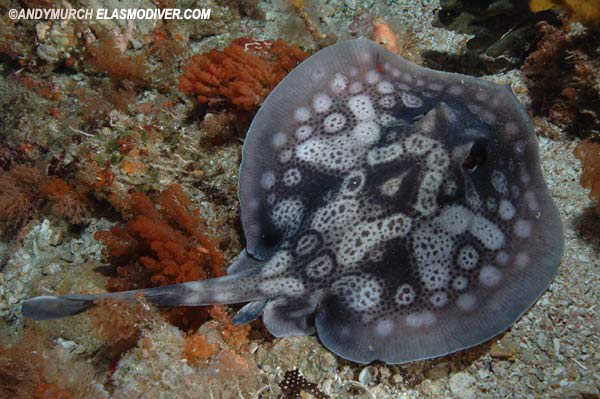|

Photograph copyright Andy
Murch
View more
Circular Stingaree Pictures in the
Shark Pictures Database
Common
Names: Circular stingaree, Sinclair's stingaree,
Spotted stingaree, banded stingaree.
Latin Name:
Urolophus
circularis. Previously grouped with Urolophus gigas.
Family:
Urolophidae
Identification:
Disc circular with small point on snout. Light grey/tan dorsum with dark
patches. Light ringed spot at centre of central dark patch on back surrounded by
a circle of light ringed spots. More dark and light spots moving outwards but
fading towards disc margin. Vague spots extend along tail. This stingaree was
previously thought to be the western color variant of the Spotted stingaree (Urolophus gigas).
Size:
Maximum
length 60cm.
Habitat:
5 - 120m.
Occasionally seen on rocky offshore reefs.
Abundance
and distribution: Rottnest Island south to Esperance, Western Australia.
Uncommon.
Behavior:
Remains motionless on reef during the day.
Reproduction:
Ovoviviparous.
Photographs:
Albany, Western Australia.
Conservation
Status: Listed as 'Least Concern' by the IUCN. It is uncommon,
but despite this and its restricted geographical range, it is rarely
encountered by fisheries in its area of occurrence. Its preference
for rocky and reefy habitat provides this species with a refuge from
trawling activities. Virtually nothing is known of its biology, but
is presumed to share life history characters with other co-occurring
urolophids. This includes low fecundity and a gestation period
approaching a year, as well as the behaviour of females commonly
aborting embryos upon capture or handling. Although it is unlikely,
if the species begun to be caught more regularly these attributes,
together with its endemism and uncommon status would be cause for
concern. However, at present and into the foreseeable future there
are no perceivable threats to the viability of this species.
Similar
species: The Spotted stingaree - Urolophus gigas.
Distinguished by broken spots on more
uniform background.
Reaction
to divers:
May flee in the presence of scuba divers but very patient when
approached closely on rebreather.
Diving
logistics: Divers occasionally
encounter this species while exploring Michaelmus and Breaksea Islands close to
Albany, Western Australia. Uwe at Albany Dive runs daily charters to the
islands and is always willing to help look for sharks and rays.
References
and Citations:
Kyne, P.M. &
White, W.T. 2006. Urolophus circularis. The IUCN Red List of
Threatened Species 2006: e.T60089A12240509.
http://dx.doi.org/10.2305/IUCN.UK.2006.RLTS.T60089A12240509.en
HOME
LINKS TAXONOMY CONTACT
|






















